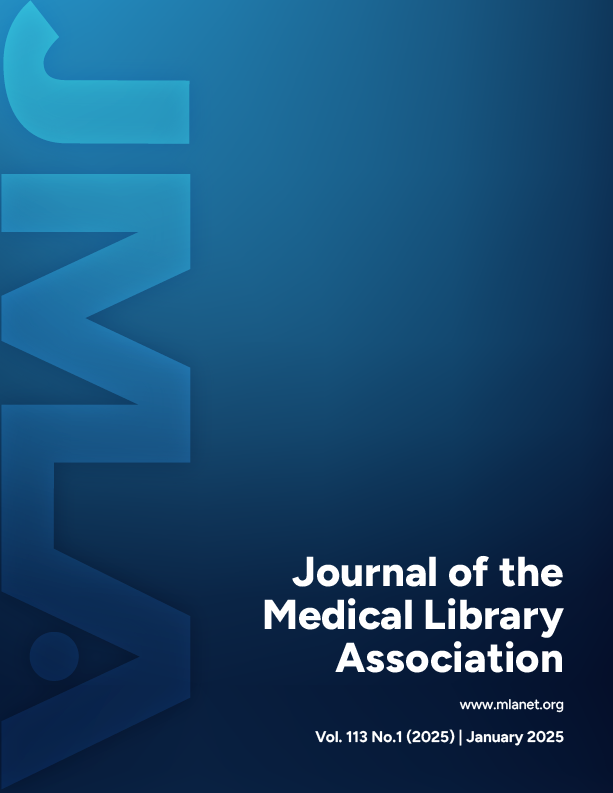Using expert knowledge and peer review to create a reproducible process for the NAHRS Nursing Essential Resources List (NNERL)
DOI:
https://doi.org/10.5195/jmla.2025.1964Keywords:
Library Collection Development, Libraries, Nursing, Case Report, Nursing and Allied Health Resources and ServicesAbstract
Background: Librarians have relied on resource lists for developing nursing collections, but these lists are usually in static or subscription-based formats. An example of this is the 26th edition of the Essential Nursing Resources last published in 2012. The Nursing and Allied Health Resources and Services (NAHRS) Caucus Nursing Essential Resources List (NNERL) Task Force has been working on a new list since Fall 2020. The goal of the Task Force is to create a nursing resource list that represents current materials and formats, uses a selection process that is transparent and reproducible, and will be available to a broad audience.
Case Presentation: Working from the Essential Nursing Resources 26th edition, the NNERL Task Force updated the purpose statement then began reviewing the resources on the list. Two working groups were formed: 1) an evaluation rubric working group developed a tool to evaluate the resources and 2) a tagging work group developed guidelines for creating metadata and “tags.” Volunteers were recruited from the NAHRS Caucus to tag the resources. Lastly, the Task Force finalized the list of resources in the NNERL then cleaned and reconciled the data.
Conclusions: The final version of the NNERL will be published in Airtable, a cloud-based project management product, that will include metadata for every item on the list. The NNERL will be copyrighted to the NAHRS NNERL Task Force and made available through the Open Science Framework (OSF) under an Attribution-NonCommercial-NoDerivatives 4.0 International Creative Commons License.
References
Jacobs SK, Bertolucci Y; Interagency Council on Information Resources in Nursing. Essential nursing resources. Nurs Educ Perspect. 2007 Sep-Oct;28(5):276-85.
Sherwill-Navarro P, Kennedy JC, Allen MP. Developing an evidence-based list of journals for nursing. J Med Libr Assoc. 2014 Apr;102(2):105-9. https://doi.org/10.3163/1536-5050.102.2.009.
Lomax E, Setterlund SK. A virtual reference shelf for nursing students and faculty. J Libr Adm. 2008 Oct 12;44(1-2):429-51. https://doi.org/10.1300/J111v44n01_06.
Owens JW. Nursing tools for the selection of library resources. Acquis Libr. 2009 Jan 20;16(31–32):89–99. https://doi.org/10.1300/J101v16n31_08.
Hill DR, Stickell HN. Brandon/Hill selected list of print nursing books and journals. Nurs Outlook. 2002 May-Jun;50(3):100-13. https://doi.org/10.1067/mno.2002.126030.
Doody’s Core Titles. Wolters Kluwer. https://www.doody.com/dct/.
Clark TR. Resource list on medication use in older adults. Generations. 2011;35(4):83-4. https://www.jstor.org/stable/26555904.
Moffitt, C. Creating a comprehensive blindness and low vision resource list. J Vis Impair Blind. 2022 Jul;116(4):563-6. https://doi.org/10.1177/0145482X221121671.
Committee of the Interagency Council on Library Tools for Nursing. Reference tools for nursing. Nurs Outlook. 1966 May;14(5):67-72.
Schnall JG, Fowler S. (2012). Essential nursing resources: one source for evidence-based nursing practice. Am J Nurs. 2012 Jan;112(1):23. https://doi.org/10.1097/01.NAJ.0000410354.34028.c3.
Raszewski R, Stark RK, Learner RC, Alcorn K, Dennison CC, Fial A, Kearney D, Wade S, Delawska-Elliott BB. Forging ahead with the NAHRS nursing essential resources list: utilizing expert knowledge and peer review processes to create a reproducible resource and workflow. Presented at: MLA ’23, the 123rd Medical Library Association Annual Meeting; Detroit, MI; May 19, 2023.12
Creative Commons. https://creativecommons.org/licenses/by-nc-nd/4.0/.
Johns Hopkins Sheridan Libraries. Evaluating information [Internet]. John Hopkins University; 2023 [cited 5 Mar 2024]. https://guides.library.jhu.edu/evaluate/sources.
Medical Library Association. Find good health information [Internet]. Medical Library Association [cited 5 Mar 2024]. https://www.mlanet.org/resources/userguide.html.
Penn State University Libraries. Evaluating information rubric [Internet]. Penn State University [cited 5 Mar 2024]. https://libraries.psu.edu/research/how/evaluating-information-rubric.
Tanner K. Survey designs. In: Williamson K, Johanson G. Research Methods: Information, Systems, and Contexts. 2nd ed. United Kingdom: Chandos Publishing; 2018:159-92. https://doi.org/10.1016/B978-0-08-102220-7.00006-6.
Kipps K, Jones AK. Collection management in the cloud: a guide for using cloud computing technologies in libraries. Blue Ridge Summitt, PA: Rowman & Littlefield Publishers; 2022:37-8.
Airtable. https://www.Airtable.com/guides/build/create-a-base.
Airtable. https://support.Airtable.com/docs/getting-started-with-Airtable-kanban-views.
Airtable. https://www.Airtable.com/guides/build/create-custom-views-of-data.
Downloads
Additional Files
Published
Issue
Section
License
Copyright (c) 2024 Rebecca Raszewski, AHIP; Lorraine Porcello; Alissa V. Fial; Carolyn C. Dennison, AHIP; Rachel Keiko Stark, AHIP; Karen S. Alcorn; Sarah Wade

This work is licensed under a Creative Commons Attribution 4.0 International License.






